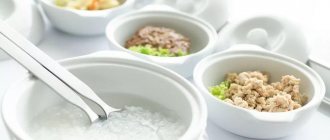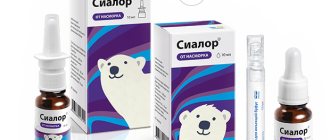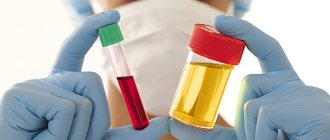Green poop in a baby can be the result of various reasons, including those that do not harm his health. However, when green stool appears, it is important to pay attention to factors such as stool consistency, frequency of bowel movements, odor, and the presence of impurities.
If you have any doubts about the child’s well-being, you should urgently seek advice from a specialist, since this symptom may also mean the presence of pathology in the child’s body.
What kind of stool should a baby have?
The baby's stool should be yellow.
The norm is that the baby's stool is yellow in color, has a mushy consistency and a sour odor.
This usually happens in children who are bottle-fed and who regularly receive food of a stable composition.
A breastfed baby's stool may vary in color, smell, and consistency. The reason for this is the composition of breast milk, which can change under the influence of many factors:
- mother's diet;
- her psycho-emotional state
- lactation period
The baby's first stool after birth is black with greenish streaks, it is very thick and tight. This stool (meconium) is normal and should not be a cause for concern.
These are epithelial cells, mucus and amniotic fluid accumulated in the intestines of a newborn. With proper development and breastfeeding of the baby, after a few days the stool becomes liquid and turns green.
During the first two months of life, the baby can have bowel movements from three to twelve times a day, ideally after each feeding. Also, stool during this period can be an indicator of proper lactation. If the baby has not had a bowel movement for 24 hours, this may indicate that he is not receiving enough milk.
How is salmonellosis treated?
Treatment depends on the form of the disease and the severity of its course.
In any case, you will need to replace fluids and salts, rehydrate, and diet. Gastric lavage may be performed and sorbents may be prescribed. The prescription of drugs to normalize digestion, bacteriophages, and even more so antibiotics, if needed, should remain entirely the prerogative of the attending physician. Young children can be sick for a long time – up to several months. In adolescents, on the other hand, symptoms usually resolve within three weeks. After recovery, a recovery period follows, during which digestive disorders persist, so the child needs a gentle diet. The prognosis is favorable in the vast majority of cases. With timely consultation with a doctor, almost all children fully recover from salmonellosis and can lead a normal life. MAKE AN APPOINTMENT PRICES
Causes of green poop in babies
During the period when teeth are being cut, there may be greenness in the stool.
Green poop in a baby can be considered normal. If your baby drinks only breast milk, the following factors can affect the greenness of the stool:
- The child’s body, in this way, gets rid of bilirubin;
- after being exposed to open air, feces oxidize;
- there are hormones in the stool that reach the baby through breast milk;
- green poop appears with the development of viral infections;
- the appearance of green poop at the age of 1 month indicates that the child’s body has not yet developed enough beneficial bacteria;
- the development of dysbacteriosis is accompanied by a pungent putrefactive odor.
- the child feeds only on liquid front milk, and cannot reach the hind (fat) milk, which gives color to the stool;
- During the period when teeth are being cut, intestinal dysfunction occurs, which can cause green stools for a short time.
The child began to be fed foods with which his intestines were not yet familiar. For some time, until adaptation has passed, how can it be green. Typically, the color of stool depends on what the baby eats along with breast milk. Green poop may appear due to:
- Mom ate little milk and a lot of greens (broccoli, dill, parsley, lettuce);
- Mom ate a lot of carbohydrates;
- the mother suffers from food poisoning, toxins that enter the child’s body through breast milk affect the color of the stool;
Green stool in formula-fed babies can occur if the baby is given a formula containing iron. The formula needs to be replaced and everything should be back to normal soon. Very often, baby poop turns green for no specific reason. If your baby is active and there are no other signs of pain, then there is no need to worry.
Thematic video will tell you about the baby’s stool:
What is salmonellosis and why is it dangerous?
Salmonellosis is an acute intestinal infection caused by bacteria of the genus Salmonella from the Enterobacteriaceae family. According to WHO, it is one of the 4 most common causes of diarrheal diseases in the world. Diseases in children are caused primarily by S. enteritidis and S. Typhimurium. Infection usually occurs through the fecal-oral route or by eating contaminated foods - meat, milk, eggs. Once in the human gastrointestinal tract, bacteria release toxins, which pose the greatest danger. Spread throughout the body, the bacteria die, releasing more toxins, which begin to affect the general condition of the patient. This infection has been known to doctors for a long time - since the 19th century, but due to its characteristics, it has not yet been defeated in the human population. Moreover, during the fight against it, several antibiotic-resistant strains that are resistant to antimicrobial drugs have emerged, which causes additional concern for pediatricians around the world. There is even a so-called “hospital strain” that spreads mainly in children's hospitals and is insensitive to many standard medications. It is no coincidence that the state sanitary and veterinary control services are involved in the prevention of this disease. Salmonella are very insidious and tenacious: they survive in open water for up to 120 days, in sea water for up to 217 days, in soil for up to 9 months, in dust for up to one and a half years, and in excrement for up to 4 years. They are resistant to low temperatures, and at room temperature they actively multiply in contaminated products without changing their taste. Neither salting nor smoking kills bacteria in food. A sick person poses a danger to others not only during the illness itself, but also some time later. In addition, there are carriers who are not sick themselves, but can become a source of infection for other people. Therefore, epidemic outbreaks of the disease still occur. As a rule, they occur during the warm season. There are 7 subspecies and more than 1,600 serotypes of Salmonella. Immunity in those who have recovered lasts at best for 1 year, and multiple infections with different strains are possible. There is also no vaccine for humans; Vaccines for animals and birds are used in agriculture. In addition, salmonellosis sometimes causes severe complications: disseminated intravascular coagulation syndrome (blood clots in small vessels), meningitis, meningoencephalitis, infectious toxic encephalopathy, osteomyelitis, pneumonia, aneurysm, etc.
Green stool in a child after one year
Allergies provoke green stools.
Green stool in a child, no matter what age, should always have a logical explanation for its origin.
If in the first months of life he speaks of disturbances in the digestive system, then in children after 1 year of age he speaks of the presence of infections. Other factors that can cause green stools:
- congenital pathologies of the digestive tract;
- development of infections;
- disruption of the immune or endocrine system;
- staphylococcal infection
- presence of intestinal parasites;
- taking certain medications
- allergy.
In any case, if the color of the stool changes, you need to be examined by a doctor and take tests to diagnose the disease and prescribe surgical treatment.
Intestinal infection
A sign of the development of infection in the intestines of a small child is the presence of shiny green streaks in the stool. This is what mucus looks like, containing a large number of intestinal bacteria. Often the infection enters the child’s body during teething, when the baby puts everything in his mouth to relieve itching in the gums. If green streaks appear in the stool, you should consult a pediatrician, at least by phone. If there are no other symptoms, it may be enough to give up complementary feeding for a while and strengthen hygiene measures: iron the baby’s clothes, boil nipples and wash toys with soap.
What does green diarrhea mean?
Dysbacteriosis is the cause of diarrhea.
If an infant has loose green stools for several days, and the baby is lethargic and restless, then this may be diarrhea, which has developed due to the following reasons:
- Intestinal infection. Occurs under the influence of E. coli, various microbes, dysentery, paratyphoid microorganisms. The first sign is a high temperature. The baby behaves restlessly, often burps, refuses food, and loose stools appear.
- Dysbacteriosis. The most common diagnosis is the gastrointestinal tract. This develops as a result of a disturbance in the composition of the microflora, which leads to malfunctions of the digestive system. In addition to green diarrhea, the child experiences bloating, colic, and skin rashes. The specialist prescribes various types of lactic bacteria and yeast.
- Viral infection. Due to the fact that the child’s immune system is not yet developed, it depends on the state of the intestinal microflora. Therefore, green diarrhea can develop from a viral infection, or even from a simple cold.
- Allergy. Mothers can be triggered by diet, changing formula, or medications. Also, when antibiotics are prescribed, diarrhea is inevitable in most cases.
Treatment
To treat diarrhea, it is important to determine the cause of the diarrhea, evaluate your overall health, and determine whether the diarrhea has led to serious complications. Therefore, if you have green diarrhea, you need to consult a doctor who will conduct an examination, collect anamnesis and prescribe a diagnosis. Treatment is recommended based on the findings. It may include taking a variety of medications, which may include:
- antibacterial drugs - prescribed for the treatment of diarrhea of bacterial origin;
- antidiarrheal agents - allow you to normalize intestinal motor function, reduce fluid loss and restore the rhythm of intestinal function;
- anti-inflammatory drugs - help relieve inflammation of the intestinal walls;
- enterosorbents - absorb toxins and remove gases.
Treatment of diarrhea is carried out comprehensively: both the underlying disease or condition that caused this symptom and the consequences of diarrhea (decrease in electrolyte levels, etc.) are eliminated.
When should you not worry?
If a mother eats spinach, the baby's stool color may change.
Yellow liquid stool may be normal in toddlers in their first year of life. When not to sound the alarm:
- the episode of loose stool is isolated;
- the baby is active, walks and is interested in toys;
- there are no signs of fever or intestinal colic;
- the tummy is not bloated or seething;
- feces are not foul-smelling or foamy.
In this case, parents should calm down and enjoy life with their little one. Yellow feces can be caused by excess juices in the diet and the period of dentition. At this time, teeth are being cut, and this puts a strain on the digestive system as well.
Features of tests for diarrhea
It is necessary to monitor the general condition of the child
To determine the causes of stool disorders, several tests are performed. Each of them is fundamentally important, helping to create a complete picture of what is happening in the body and make the right prescriptions.
- A CBC is needed to determine the severity of inflammatory processes. If diarrhea is infectious, there will be significant changes in leukocyte counts and ESR.
- Coprogram. This examination reveals malfunctions in the enzymatic system, shows the functioning of the pancreas, helps to find out what the nature of the problem is, how severely the intestinal function is impaired. If diarrhea is in the acute stage, you won’t get the full picture. Therefore, it is necessary to first stabilize the condition, and then conduct an examination.
- A stool test for dysbacteriosis identifies bacteria living in the intestines. The resulting list of pathogenic microorganisms will help prescribe adequate therapy. After all, Staphylococcus aureus is susceptible to the effects of some drugs, and Klebsiella – to others. Timely detection of enterococci and Proteus is important. The same analysis shows whether there are beneficial bacteria. As a rule, with diarrhea they are present in minimal quantities and may be almost completely absent. This type of examination has its drawbacks. It is not done quickly: at least 5 days. And in most cases it is offered to be done at the paid services department.
- A stool/worm test is necessary to rule out helminth infection. After all, the vital activity of worms often provokes attacks of diarrhea.
- Stool culture. Such an examination gives a picture of infection with infectious diseases. The analysis takes about a week. Moreover, they can prescribe cultures for dysentery, typhoid group, staphylococci, etc.
Causes and types
Constipation in a child may be one of the manifestations of diseases not directly related to the pathology of the gastrointestinal tract (such as rickets, hypothyroidism). However, in the vast majority of cases, constipation is caused by problems with the intestines themselves.
During the process of digestion, the intestinal walls contract in waves, pushing the contents towards the outlet - this phenomenon is called peristalsis or intestinal motility.
There are two main options for intestinal motility disorders:
- If the child’s stool is very rare, accompanied by bloating, and when the intestines empty the volume of stool is large (as in an adult), we can assume that he has so-called atonic constipation . Constipation associated with insufficient contractile activity of the intestines is called atonic. In this case, the child may not have the urge to defecate for a long time. Compulsory measures (long-term potty training) usually only aggravate the situation and reinforce the child’s negative attitude towards what is happening.
- Thick stools consisting of hard, smooth pellets (the so-called “sheep feces”), abdominal pain, and sometimes pain during defecation usually indicate spastic constipation . Spastic constipation in children occurs due to spasms (increased contractile activity) of the intestines.
In some cases, stool is released in the form of a ribbon or a thin stream. In such a situation, the child should be consulted with a surgeon to exclude organic pathology of the rectum (narrowing, neoplasm).











